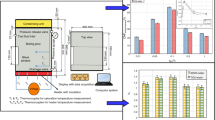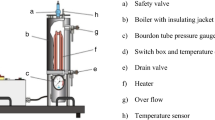Abstract
Experimental measurements were carried out on the boiling heat transfer characteristics of γ-Al2O3/water and SnO2/water Newtonian nanofluids. Nanofluids are liquid suspensions containing nanoparticles with sizes smaller than 100 nm. In this research, suspensions with different concentrations of γ-Al2O3 and SnO2 nanoparticles in water were studied under nucleate pool boiling heat transfer conditions. Results show that nanofluids possess noticeably higher boiling heat transfer coefficients than the base fluid. The boiling heat transfer coefficients depend on the type and concentration of nanoparticles.






Similar content being viewed by others
Abbreviations
- A :
-
Heater surface area (m2)
- C p :
-
Heat capacity of the fluid (J/kg K)
- g :
-
Gravitational acceleration (m/s2)
- h:
-
Boiling heat transfer coefficient (W/m2 K)
- h fg :
-
Latent heat of evaporation of the fluid (J/kg)
- k l :
-
Thermal conductivity (W/m K)
- Pr :
-
Prandtl number
- q :
-
Power (W)
- q″:
-
Heat flux density (W/m2)
- T s :
-
Surface temperature (K)
- T b :
-
Fluid bulk temperature (K)
- μ :
-
Fluid viscosity (N s/m2)
- ρ l :
-
Liquid density (kg/m3)
- ρ v :
-
Vapour density (kg/m3)
- σ :
-
Surface tension (N/m)
- ΔT e :
-
Excess temperature (K)
- b :
-
Bulk
- e :
-
Excess
- l :
-
Liquid
- s :
-
Surface
- v :
-
Vapour
References
Cheng L, Mewes D, Luke A (2007) Boiling phenomena with surfactants and polymeric additives: a state-of-the-art review. Int J Heat Mass Transf 50:2744–2771
Bang IC, Chang SH (2005) Boiling heat transfer performance and phenomena of Al2O3–water nanofluids from a plain surface in a pool. Int J Heat Mass Transf 48:2407–2419
Incropera P, Dewitt P (2002) Introduction to heat transfer, 4th edn, vol 2. Wiley, New York, USA
Choi SUS (1995) Enhancing thermal conductivity of fluid with nanoparticles. ASME, FED, 231/MD 66:99–105
Eastman JA, Choi SUS, Thompson LJ, Lee S (1997) Enhanced thermal conductivity through the development of nanofluids. In: Proceedings of the symposium on nanophase and nanocomposite materials II, Material Research Society, Boston, pp 3–11
Lee S, Choi SUS, Li S, Eastman JA (1999) Measuring thermal conductivity of fluids containing oxide nanoparticles. J Heat Transf 121:280–289
Wen DS, Ding YL (2004) Effective thermal conductivity of aqueous suspensions of carbon nanotubes (nanofluids). J Thermophys Heat Transf 18:481–485
Xuan YM, Li Q (2003) Investigation on convective heat transfer and flow features of nanofluids. ASME J Heat Transf 125:151–155
Wen D, Ding Y (2004) Experimental investigation into convective heat transfer of nanofluid at the entrance rejoin under laminar flow conditions. Int J Heat Transf 47:5181–5188
Zeinali Heris S, Nasr Esfahany M, Etemad G (2006) Investigation of CuO/water nanofluid laminar convective heat transfer through a circular tube. J Enhanc Heat Transf 13:279–289
Das SK, Putra N, Roetzel W (2003) Pool boiling characteristics of nanofluids. Int J Heat Mass Transf 46:851–862
Das SK, Putra N, Roetzel W (2003) Pool boiling of nanofluids on horizontal narrow tubes. Int J Multiph Flow 29:1237–1247
You SM, Kim JH, Kim KH (2003) Effect of nanoparticles on critical heat flux of water in pool boiling heat transfer. Appl Phys Lett 83:3374–3376
Witharana S (2003) Boiling of refrigerants on enhanced surfaces and boiling of nanofluids, Ph.D. thesis, Royal Institute of Technology, Stockholm
Vassllo P, Kumar R, Amico SD (2004) Pool boiling heat experiments in silica-water nano-fluids. Int J Heat Mass Transf 47:407–411
Tu JP, Dinh N, Theofanous T (2004) An experimental study of nanofluid boiling heat transfer. In: Proceedings of 6th international symposium on heat transfer, Beijing, China
Wen D, Ding Y (2005) Experimental investigation into the pool boiling heat transfer of aqueous based γ-alumina nanofluids. J Nanopart Res 7:265–274
Rohsenow WM (1952) A method of correlating heat transfer data for surface boiling of liquids. Trans ASME 74:962–976
Dutta BK (2001) Heat transfer principles and applications. Prentice-Hall, New Delhi
Acknowledgments
The financial support of Nanotechnology Committee of The Ministry of Science, Research, and Technology of I.R. Iran is gratefully acknowledged.
Author information
Authors and Affiliations
Corresponding author
Rights and permissions
About this article
Cite this article
Soltani, S., Etemad, S.G. & Thibault, J. Pool boiling heat transfer performance of Newtonian nanofluids. Heat Mass Transfer 45, 1555–1560 (2009). https://doi.org/10.1007/s00231-009-0530-9
Received:
Accepted:
Published:
Issue Date:
DOI: https://doi.org/10.1007/s00231-009-0530-9




